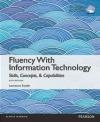Fluency With Information Technology: Global Edition
Lawrence Snyder
Fluency With Information Technology: Global Edition
Lawrence Snyder
- Producent: Pearson
- Rok produkcji: 2014
- ISBN: 9781292061245
- Ilość stron: 784
- Oprawa: Miękka
Niedostępna
Opis: Fluency With Information Technology: Global Edition - Lawrence Snyder
For the introduction to Computer Science course Fluency with Information Technology: Skills, Concepts, and Capabilities equips readers who are already familiar with computers, the Internet, and the World Wide Web with a deeper understanding of the broad capabilities of technology. Through a project-oriented learning approach that uses examples and realistic problem-solving scenarios, Larry Snyder teaches readers to navigate information technology independently and become effective users of today's resources, forming a foundation of skills they can adapt to their personal and career goals as future technologies emerge. Teaching and Learning Experience This program presents a better teaching and learning experience-for you and your students. *Skills, Concepts, and Capabilities Promote Lifelong Learning: Three types of content prepare students to adapt to an ever-changing computing environment. *Engaging Features Encourage Students to become Fluent with Information Technology (FIT): Interesting hints, tips, exercises, and backgrounds are located throughout the text. *Student and Instructor Resources Enhance Learning: Supplements are available to expand on the topics presented in the text.PART 1 Becoming Skilled at Computing Chapter 1 Defining Information Technology Terms of Endearment 3 Computation's Greatest Hits 5 Terms of Endearment 14 Computers, Software, Algorithms 15 The Words for Ideas 19 Summary 22 Try It Solutions 22 Review Questions 22 Chapter 2 Exploring the Human-Computer Interface Face It, It's a Computer 25 A Few Useful Concepts 27 Perfect Reproduction 29 What We See and What We Think 34 Summary 38 Try It Solutions 38 Review Questions 39 Chapter 3 The Basics of Networking Making the Connection 43 Comparing Communication Types 45 The Medium of the Message 48 The World Wide Web 60 File Structure 63 Summary 67 Try It Solutions 67 Review Questions 68 Chapter 4 A Hypertext Markup Language Primer Marking Up with HTML 71 Marking Up with HTML 73 Lab Practice I 75 Structuring Documents 78 Lab Practice II 83 Get Into Style with CSS 85 Marking Links and Images 88 Referring to Files 91 Span, Lists, Tables, and Boxes 93 Cascading Style Sheets 99 Styling with Class 101 Hovering Above Links 104 HTML Wrap-Up 106 Summary 107 Try It Solutions 108 Review Questions 108 Chapter 5 Locating Information on the WWW The Search for Truth 113 Web Search Fundamentals 115 Advanced Searches 121 Web Searching 126 Authoritative Information 131 Truth or Fiction? 135 Summary 139 Try It Solutions 139 Review Questions 140 Chapter 6 An Introduction to Debugging To Err Is Human 143 Precision: The High Standards of Computing 145 Debugging: What's the Problem? 145 A Dialog About Debugging 147 Debugging Recap 151 Fixing HTML Bugs: A Case Study 152 No Printer Output: A Classic Scenario 162 Ensuring the Reliability of Software 165 Community Debugging 166 Summary 167 Try It Solutions 167 Review Questions 168 Interview with Vinton G. Cerf 171 PART 2 Algorithms and Digitizing Information Chapter 7 Representing Information Digitally Bits and the "Why" of Bytes 177 Digitizing Discrete Information 179 Information Representation 181 Binary and Hex 185 Digitizing Numbers in Binary 187 Digitizing Text 190 UTF-8 194 The Metadata and the OED 195 Summary 200 Try It Solutions 200 Review Questions 201 Chapter 8 Representing Multimedia Digitally Light, Sound, Magic 203 Digitizing Color 205 Computing on Representations 212 Digitizing Sound 218 Digital Images and Video 221 Optical Character Recognition 226 Multimedia Challenges 228 Bits Are It 229 Summary 230 Try It Solutions 230 Review Questions 231 Chapter 9 Principles of Computer Operations Following Instructions 235 There's an App for That 237 Software Isn't So Hard 238 Instruction Execution Engine 242 The Program Counter: The PC's PC 248 Instruction Execution 249 Translation 254 Integrated Circuits 257 How Semiconductor Technology Works 260 Combining the Ideas 262 Summary 264 Try It Solutions 264 Review Questions 265 Chapter 10 Algorithmic Thinking What's the Plan? 269 Algorithms 271 Algorithms-A Basic Concept 277 A Closer Look 278 Doing the Right Thing 282 Summary 285 Try It Solutions 285 Review Questions 286 Interview with Ray Kurzweil 288 PART 3 Data and Information Chapter 11 Social Implications of IT Computers in Polite Society 295 The Power of the Crowd 297 Out on Good Behavior 299 Expect the Unexpected 303 Creating Good Passwords 304 Spam 309 Scams 310 Protecting Intellectual Property 315 Creative Commons 319 Summary 321 Try It Solutions 322 Review Questions 322 Chapter 12 Privacy and Digital Security Shhh, It's a Secret 327 Privacy and Technology 329 A Privacy Definition 330 Enjoying the Benefits of Privacy 331 Fair Information Practices 332 Is There No Privacy? 333 Tracking 336 Cookies 340 Digital Security 342 Prevention 345 Encryption 349 Redundancy Is Very, Very, Very Good 355 Summary 358 Try It Solutions 359 Review Questions 359 Chapter 13 The Basics of Spreadsheets Fill-in-the-Blank Computing 363 Arranging Information 365 Computing with Spreadsheets 369 Daily Spreadsheets 378 Importing Data 384 Summary 389 Try It Solutions 390 Review Questions 390 Chapter 14 Advanced Spreadsheets for Planning "What If" Thinking Helps 395 Designing a Spreadsheet 397 Conditional Formatting 400 Conditional Formulas 403 Naming: Symbolic Reference 406 "What If " Analysis 409 Analyzing Data Using Filtering 415 Summary 419 Try It Solutions 420 Review Questions 420 Chapter 15 Introduction to Database Concepts A Table with a View 423 Differences Between Tables and Databases 425 XML: A Language for Metadata Tags 426 Tables and Entities 432 The Science of Tables 435 SQL: The Language of Databases 446 Structure of a Database 449 Summary 451 Try It Solutions 451 Review Questions 452 Chapter 16 A Case Study in Database Organization The iDiary Database 455 Thinking About a Personal Database 457 A Preliminary Exercise 458 The iDiary Database 468 Using the iDiary Daily 478 Summary 480 Try It Solutions 480 Review Questions 481 Interview with Alan Kay 483 PART 4 Problem Solving Chapter 17 Fundamental Concepts Expressed in JavaScript Get with the Program 489 Overview: Programming Concepts 491 Names, Values, and Variables 492 Three Basic Data Types of JavaScript 496 The Assignment Statement 499 Lab Practice 502 An Expression and Its Syntax 504 A Conditional Statement 508 The Espresso Program 513 Summary 515 Try It Solutions 516 Review Questions 517 Chapter 18 A JavaScript Program The Bean Counter 521 Preliminaries 523 Background for the UI 524 Creating the Graphical User Interface 527 Event-Based Programming 530 Critiquing the Bean Counter 534 Bean Counter Recap 537 Summary 538 Try It Solutions 538 Review Questions 539 Chapter 19 Programming Functions Thinking Big 543 Anatomy of a Function 545 Forms and Functions 548 Writing Functions, Using Functions 550 Customizing Pages 556 Making a Web-Based Phone App 559 Social Functions 564 Summary 570 Try It Solutions 571 Review Questions 572 Chapter 20 Iteration Principles Once Is Not Enough 575 Iteration: Play It Again, Sam 577 JavaScript Rules for for Loops 579 Experiments with Flipping Coins 582 Indexing 587 Arrays 588 It's Magic 590 The Busy Animation 592 Not So Busy Animation 597 Summary 599 Try It Solutions 600 Review Questions 602 Chapter 21 A Case Study in Algorithmic Problem Solving The Smooth Motion Application 605 The Smooth Motion Application 607 Planning Smooth Motion 608 Build the Basic Web Page UI 611 Animate the Grid 612 The Best Laid Plans ... 616 Build Controls 617 Sense the Keys 618 Staircase Detection 621 Assemble Overall Design 622 Primp the Design 624 Summary 625 Try It Solutions 626 Review Questions 627 Chapter 22 Limits to Computation Computers Can Do Almost {Q Everything, Q Nothing} 629 Can Computers Think? 631 Acting Intelligently? 633 Watson 638 Acting Creatively? 642 The Universality Principle 645 More Work, Slower Speed 648 Are "Best" Algorithms All Fast? 649 Summary 651 Try It Solutions 652 Review Questions 652 Chapter 23 A Fluency Summary Click to Close 655 Two Big Computing Ideas 657 Fluency: Less Is More 658 Lifelong IT Learning 660 Shifting for Yourself 662 Try It Solutions 662 Review Questions 662 Interview with David Ferrucci 664 Appendix A HTML5 Reference 669 Appendix B RSA Public Key Cryptosystem 675 Appendix C iDiary: Tags and Templates 681 Appendix D JavaScript Programming Rules 687 Appendix E The Bean Counter Program 695 Appendix F myApps Page 699 Appendix G Smooth Motion Program 707 Glossary 711 Answers to Selected Questions 721 Index 731 Credits 751
Producent:
GPSR Pearson Central Europe Sp. z o.o.
ul. Szamocka 8
01-748 Warszawa (PL)
tel: 459 596 060
email: [email protected]
Szczegóły: Fluency With Information Technology: Global Edition - Lawrence Snyder
Tytuł: Fluency With Information Technology: Global Edition
Autor: Lawrence Snyder
Producent: Pearson
ISBN: 9781292061245
Rok produkcji: 2014
Ilość stron: 784
Oprawa: Miękka
Waga: 1.45 kg






























